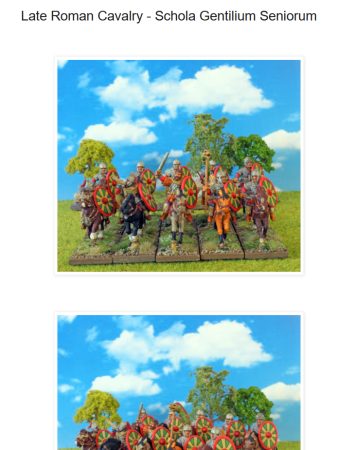I wanted to modify the helmet to have the side tubes that hold feathers on the helmet.
I marked small lines on the side of the helmet in the direction I wanted the tubes to align with. I then followed these lines with a twist drill (Photo 10A). I placed into the holes small sections of 0.030" diameter styrene rod that had been drilled out with a #78 twist drill. The rods were held in place with superglue. Wires were placed into the holes in the rod to improve alignment before gluing (Photo 10B). Each rod was then packed with Apoxie Sculpt and smoothed with a wet finger. When hard, the epoxy was lightly sanded with 320-grit wet/dry sandpaper and a little water, and then primed gray.

I always find bronze a tough material to render. When we see bronze armor today, it's always corroded - a gray green. You look at the helmets of re-enactors: it is a dazzling mirror-finish that looks like brass. What was the level of finish actually used back in the day?
I searched the web to look at some of the forms bronze takes. Photo 11B-E are some of the levels of finishing and patina. I also have some metallic bronze powder intended for oils. The powder has a red tint to it and somewhat resembles Vallejo Tinny Tin, so I used that for the mix.

The helmet was given an initial coat of Tinny Tin, RI Brown Ink, and Dark Burnt Umber (2:1:1). A circle under the helmet was given a coat of the base flesh color, and what hair could be seen was painted black. (Photo 12A).
Now that the basic colors are in, time to attach the head to the body. I put 5-minute epoxy in the pin hole, and a donut of Apoxie Sculpt around the neck. Helmet and head were held together while the 5-minute epoxy hardened. When the epoxy had hardened, the Apoxie Sculpt was still soft. The excess Apoxie Sculpt was smoothed over with a wet, cheap brush (Photo 12B) and will be hidden by a coat of base flesh.
Photo 12C is the beginning of highlighted bronze layers. Tinny Tin, Brass, and MW layers in ratios of 2:1:1, 2:2:2, 2:4:3, and the final on just the edges 2:8:3. Pure Brass was used on the edges of the front-embossed head. The culmination of the bronze can be seen in Photo 12D, as well as the plume basecoat of Barn Red. The high edges of the plume were drybrushed white, followed by a drybrush of Cardinal Red (Photo 12E).

The feathers were leveraged from the fern experiments of the German Leader. I originally tried to cut the feathers out of thin styrene, and glue a wire in a slot to act as a quill. I'd hoped this would be more robust than the paper used for the fern, but it was not. I ended up using paper and 32-gauge wire.
The feathers were coated White, and then light lines of White and Cadet Grey were painted on to suggest the quills and ridges. Just a couple drops of superglue to hold the feathers, and the helmet is good to go.









